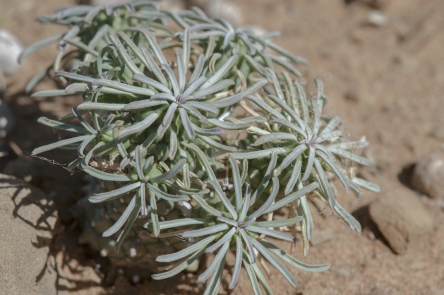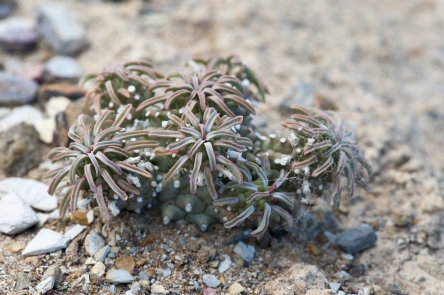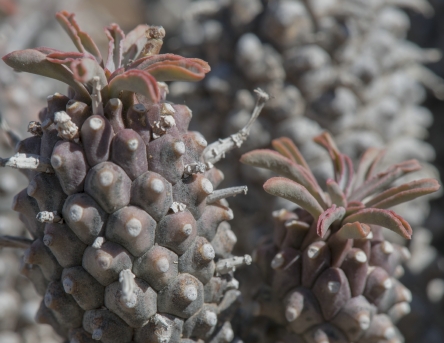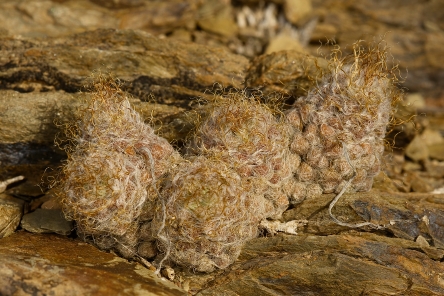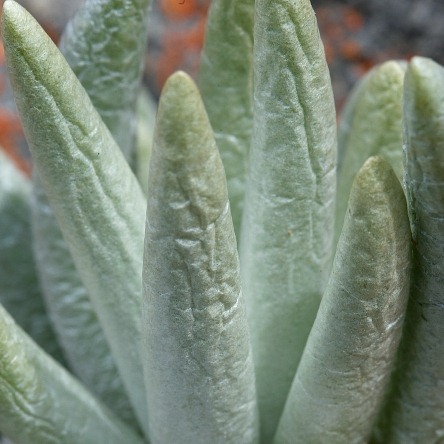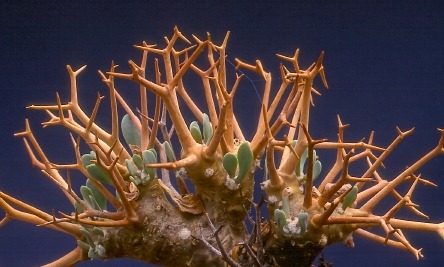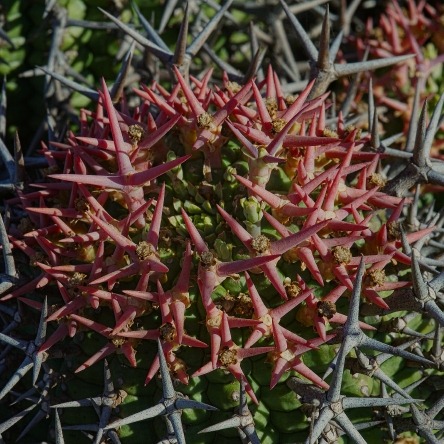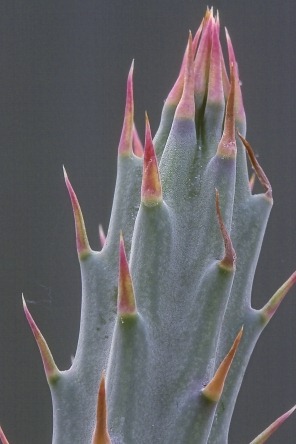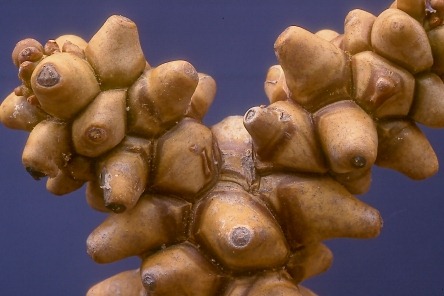A few months ago I mentioned an article that I had written for “Veld & Flora” . Now that this has been published, I will share it with you here in a slightly modified version.
***
Succulent plants come in all shapes and sizes. Some of them, like baobabs and certain cacti, are enormous, able to store great quantities of water. At the other end of the scale, we find the results of a trend towards reduction that can be seen in several unrelated families such as Aizoaceae, Asphodelaceae, Asteraceae, Crassulaceae, Euphorbiaceae and Portulacaceae. These miniature succulents are both small and compact, not taller than a few centimeters, often little branched, without visible internodes and with more or less spherical leaves or stem(s). (In case you don’t know: an internode is the part of a stem between the points where leaves or branches develop).
Sometimes the trend involves neoteny. This is a situation in which plants or animals retain juvenile or embryonic characteristics throughout their life span, but nevertheless are able to reproduce. (A famous case in the animal kingdom is the Mexican axolotl).
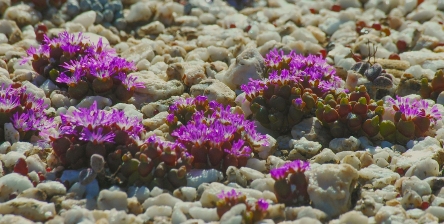
An interesting example in plants is the genus Oophytum, which only occurs on the Knersvlakte. It is a member of the Mitrophyllum group that only produces juvenile leaves. In effect, they are therefore perpetual seedlings.
Among succulent plant enthusiasts, miniatures are long-time favorites. This is hardly surprising, because even a small space can harbour a nice collection of them. There’s also an amazing abundance of shapes and colours, so that even without flowers there is always something to marvel over.
Last but not least, there’s great variety in their survival needs. In other words, both beginners and advanced growers will be able to find plants that fit their knowledge and ability. To grow some of these plants from seed to maturity is quite a feat, whereas others are much more amenable.
Even if you are not interested in keeping plants in captivity, there are many reasons for having a closer look at these dwarfs. In this article, we will focus on the way they cope with the challenges of their environment and make use of its opportunities.
Being small has both advantages and disadvantages, some of them evident, others much less so. Often the situation is rather complex. The solution for a problem may create a new problem, which in some cases is then (partly) remedied by another solution. Trying to understand this balancing act is an interesting exercise.
The accompanying pictures will hopefully convince you that these plants are not just interesting; they are also beautiful and visually stimulating.
The most obvious advantage of being small is that you need only little water, food and space to thrive. (Of course, the opposite is also true: when there is an abundance of these necessities, small succulents cannot compete with faster growing plants).
Because dwarf succulents can store only small amounts of water at a time, their storage organs have to be refilled at regular intervals, so the supply should be dependable. For that reason, the great majority of them occur in the Succulent Karoo, especially in Namaqualand with its predictable winter rainfall supplemented by even more reliable fog and dew.
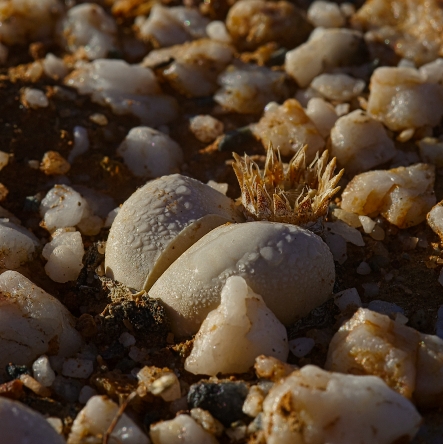
The hygroscopic fruit of this Argyroderma delaetii is still open early in the morning, as a result of the heavy nightly dew
The Succulent Karoo is not the only winter-rainfall desert in the world. Others are the southern Atacama Desert in Chile, the northwestern part of Baja California and the southern coast of Morocco. The first two especially, support a lot of succulents, but few if any of these are miniatures. In that sense, one could say that these little gems are a Southern African “invention”
The Succulent Karoo contains the richest concentration of succulents in the world. Whereas only about 140 species of stem succulents grow here, there are about 1700 species of leaf succulents, about 700 of which are small and compact. During the growing season, which is not just moist but also cool, these miniatures profit from the warmth of the soil.
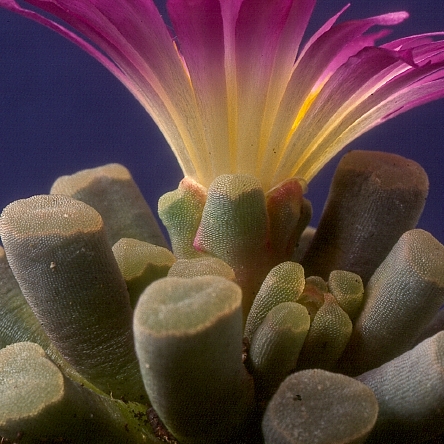
One of the few miniature succulents occurring outside the Succulent Karoo is this beautiful Frithia pulchra from Gauteng

Not many stem succulents qualify as a miniature, but this Euphorbia pseudoglobosa from the Little Karoo certainly does
Small succulents are often restricted to places where water easily runs off, like gravel plains and quartz fields. Between and under rocks and stones, rainwater is often collected, providing moisture for small plants. In addition, dew and mist condenses on rocks and the moisture accumulates at their bases and in crevices. (Apart from water, this kind of habitat often also provides shade and protection from predators).
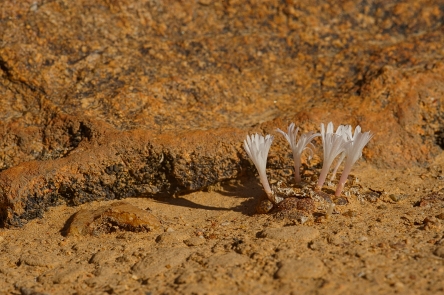
This Conophytum pellucidum, photographed near Kamieskroon, looks quite happy with the little bit of extra water that collects at the foot of a rock slab
To be continued.

